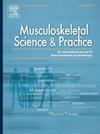Exercise-based rehabilitation for ACL injuries: a systematic review and meta-analysis
IF 2.2
3区 医学
Q1 REHABILITATION
引用次数: 0
Abstract
Background
Despite the lack of clear benefit of surgery for Anterior Cruciate Ligament (ACL) injury and the uncertain cost-effectiveness, the rates of surgery are increasing. Therefore, a better insight in the benefits of exercise is needed.
Objective
Evaluate the effectiveness of exercises in people with an ACL injury.
Design
Systematic review and meta-analysis.
Methods
We searched 5 databases for randomized trials investigating exercise interventions for the management of ACL injuries. We assessed the methodological quality and completeness of exercise reporting and performed a meta-analysis using a random-effects model. The certainty of evidence was assessed using GRADE.
Results
We included 18 trials (n = 1433); four compared exercises with no treatment, eight compared various exercises, and six trials compared exercise to surgery. Single studies showed (very uncertain) benefit of Tai Chi and Pilates on pain or recovery compared to no treatment; the pooled evidence showed no differences on function (MD = −2.2; 95 %CI -6.5 to 2.1). Pooled evidence shows no differences (moderate certainty) between various exercises in function (SMD = −0.07; 95 %CI -0.4 to 0.3). Only one single study showed benefit of additional perturbation training on recovery (very uncertain). We found moderate certainty for no differences between exercise and surgery on pain (MD = −3.5; 95 %CI -7.9 to 1.0), and for a small benefit of surgery on function (MD = −4.3; 95 %CI: −6.7 to −1.8).
Conclusion
We found very uncertain benefit of exercise over no treatment, but no exercise was likely more beneficial than another. Compared to exercise, surgery shows no benefit on pain, but a small improvement in function.
基于运动的前交叉韧带损伤康复:系统回顾和荟萃分析。
背景:尽管手术治疗前交叉韧带(ACL)损伤缺乏明确的益处和不确定的成本效益,但手术的比例正在增加。因此,需要更好地了解运动的好处。目的:评价运动对前交叉韧带损伤的治疗效果。设计:系统回顾和荟萃分析。方法:我们检索了5个数据库的随机试验,研究运动干预对前交叉韧带损伤的管理。我们评估了运动报告的方法学质量和完整性,并使用随机效应模型进行了荟萃分析。使用GRADE评估证据的确定性。结果:我们纳入了18项试验(n = 1433);四项试验比较了不治疗的运动,八项试验比较了各种运动,六项试验比较了运动和手术。单一研究表明(非常不确定)与没有治疗相比,太极拳和普拉提对疼痛或康复有好处;综合证据显示功能无差异(MD = -2.2; 95% CI -6.5至2.1)。综合证据显示,各种运动在功能方面没有差异(中等确定性)(SMD = -0.07; 95% CI -0.4至0.3)。只有一项研究显示额外的扰动训练对恢复有好处(非常不确定)。我们发现运动和手术在疼痛方面没有差异(MD = -3.5; 95% CI: -7.9至1.0),手术在功能方面有小的好处(MD = -4.3; 95% CI: -6.7至-1.8)。结论:我们发现运动的益处并不确定,但没有运动可能比其他运动更有益。与运动相比,手术对疼痛没有好处,但对功能有一点改善。
本文章由计算机程序翻译,如有差异,请以英文原文为准。
求助全文
约1分钟内获得全文
求助全文
来源期刊

Musculoskeletal Science and Practice
Health Professions-Physical Therapy, Sports Therapy and Rehabilitation
CiteScore
4.10
自引率
8.70%
发文量
152
审稿时长
48 days
期刊介绍:
Musculoskeletal Science & Practice, international journal of musculoskeletal physiotherapy, is a peer-reviewed international journal (previously Manual Therapy), publishing high quality original research, review and Masterclass articles that contribute to improving the clinical understanding of appropriate care processes for musculoskeletal disorders. The journal publishes articles that influence or add to the body of evidence on diagnostic and therapeutic processes, patient centered care, guidelines for musculoskeletal therapeutics and theoretical models that support developments in assessment, diagnosis, clinical reasoning and interventions.
 求助内容:
求助内容: 应助结果提醒方式:
应助结果提醒方式:


